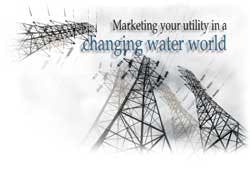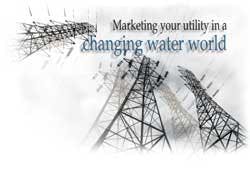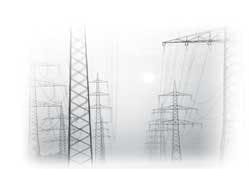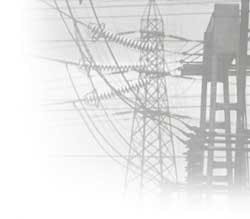Marketing your utility in a changing water world
By Marc Jacobson
Few water utilities place significant emphasis on marketing. Utilities have had few reasons to "sell" their product given their primary focus on safety and supply, and with rates established through political process and cost evaluation.
The water marketplace, however, is changing. Supply problems are increasing the requirement for voluntary and mandatory conservation programs that must be "sold" to customers. Voters may be asked to approve massive new investments in infrastructure and security. The need to communicate with customers and to build their confidence is clearly increasing.
Deregulation is also having an effect on utilities' need to market. Increasingly, water and wastewater utilities are following gas and electric utilities into the era of investor ownership. They are developing unregulated subsidiaries and, in a number of cases, privatising completely. A consensus is growing that water companies, both public and private, can develop and offer products and services that will use market forces to stretch increasingly constrained water resources to meet increasing demands. Such significant changes require water companies and utilities to focus in new ways on customer needs and preferences – to become more "customer – centric"– and to use marketing as a tool to demonstrate their commitment to customers.
Anticipating a less-regulated future, many water utilities have begun to develop or increase emphasis on marketing departments. They are consolidating customer information and assembling the tools and processes needed for analysis. These are wise investments, even in regions where the discussion of public versus private ownership has only just begun. No matter what the future holds, all parties involved, such as regulators, investors and the public, are virtually certain to require utilities to pay increased attention to customer needs as cooperation is sought in using vital water resources wisely.
As regulated industries change to become increasingly customer-centric, they generally follow an evolutionary pattern from tight regulation to full competition. At the fully regulated end is the narrowly defined utility, tightly constrained by regulation and delivering only basic commodity services– water in, wastewater out. At the other is the full-agenda utility offering a substantial menu of products and services and operating either under a regulatory regime that encourages customer responsiveness or under partial or full deregulation.
In planning the future, it is helpful to assess just where your company is in this evolutionary process and to note especially the central role played by marketing and by the customer information it assembles and channels to other organisations.
Stage 1: Utilities operating under tight regulation
Regulatory regimes that focus exclusively on low cost of service give water utilities little reason to see customers as anything other than meters or bills. The corporate structure reflects that attitude, with functionally defined units that do not readily share information. The management style tends toward "command and control"; staff carries out top-down orders and are evaluated primarily on quantity of output.
Customer processes are not easily linked in this severely restricted utility. Customer service is considered a billing function. All customers in a class – residential, commercial – are assumed to want the same thing, and they receive a uniform set of services. "Good" service is synonymous with "low-cost" service. The utility may put its own convenience ahead of that of customers to maintain that cost profile. To the extent that this utility markets, for instance, to solicit participants in conservation or facilities maintenance contracts, it uses impersonal forms like direct mail or bill stuffers.
Similarly, sales are largely reactive. New customers identify themselves by calling to start service. If pro-active sales are needed the company may use telephone sales, often outsourced and managed by the marketing department in ways designed merely to reach the target number as quickly and inexpensively as possible.
Few utility staff members want to operate so impersonally but the regulatory demand for low prices has distanced utilities from their customers in many situations.
Stage 2: Utilities recognise customers as sources of revenue and profit
Water utilities may come to this stage via several routes. Customers may lodge complaints with utility commissions. A regulatory change may make it possible for utilities to offer new or unregulated products or services through affiliates.
Utilities responding to these stimuli tend to focus on how to get customers to buy what the utility is offering, not how to change offerings to meet customer needs. To accomplish that, marketing begins to gather information using rudimentary customer segmentation schemes, such as rate class. The information gathered is often simple demographics, not buying behaviours or customer preferences. There is little data integration, but information is robust enough to permit marketing to "personalise" products and services, in addition to marketing campaigns, by segment-an outdoor hose shut-off valve for consumers, more sophisticated filtering equipment for water-using processing plants.
Sales forces at this stage are still highly restricted, however. They have little latitude to customise products or services for an individual customer in a segment. Most sales are seen as "one off." To the extent that marketing and sales use customer management systems, they are not generally tied into back-office systems at this stage.
Stage 3: Utilities recognise customer value
Utilities take an important step when they move from seeing customers as sources of revenue to seeing customers as sources of value. At this stage, utilities focus on the need to build long-term customer relationships.
• They begin to build the systems and gather the data to maintain information on customers as individuals.
• Insights from studying customer behaviour and needs begin to creep into the development of products and services and into the way they're offered.
• Sales organisations can personalise service for the individual customer.
• Service becomes a sales channel.
• The company invests in a formal, enterprise-wide customer relationship system integrated into back-office systems.
• Marketing, sales, and service are viewed as a complete customer relationship lifecycle around which the company may reorganise.
• Success is judged by the total cost of the relationship over time.
• Sales channels begin to multiply based on how customers prefer to buy rather than how the company prefers to sell.
Stage 4: Utilities' primary focus is on individual customers
Utilities and private water companies that respond fully to customers' changing needs tend to:
• Organise around the buying process to the extent possible.
• Grant maximum empowerment to customer-facing employees.
• Incorporate customer input into product and service offerings.
• Sell through channels that match the way customers want to buy. No matter which channel customers use, they receive the same high service level.
• Personalise service and use it as a sales channel.
• Measure customer value in terms of how valuable the company is to the customer, not the other way around.
No matter what the future holds for water and wastewater utilities, there will always be customers. And no matter which position on the continuum your utility holds, there is always a role for good marketing. If your organisation hasn't started a serious expansion of its marketing outreach, the time to do so is now. Every investment in solid customer management is an investment in the future.
Author's noteMarc Jacobson works for the Transformance Group, a division of SPL WorldGroup, based in San Francisco, California, USA. For more information, visit the website at http://www.splwg.com



